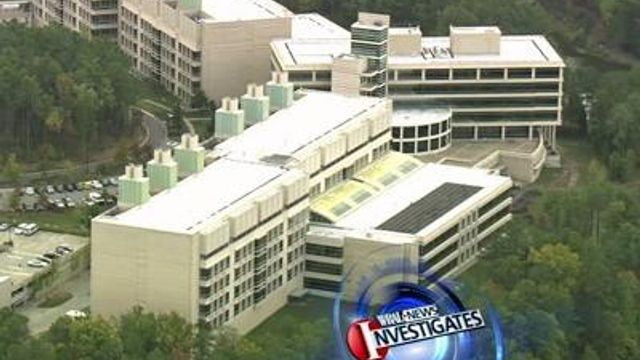Air-quality scientists report air problems in their RTP building
Scientists who work at the Environmental Protection Agency's sprawling campus in Research Triangle Park are at the forefront of research into air quality, but some have become the test subjects in an air-quality mystery that has left them sick.
Posted — UpdatedThursday's memo also mentions "visible mold growth." Yet, facilities manager Alex Montilla downplayed the mold concerns in an interview with WRAL Investigates last Friday.
Many EPA employees, who did not want to be identified for fear of losing their jobs, said they face a stigma because not everyone inside the building is affected. Some co-workers doubt the illnesses are real, they said.
Opened in November 2002, the EPA campus was touted as a state-of-the-art facility. The agency even dedicated a section of its website to discuss the extreme measures taken to protect the air quality at the facility. Inside those buildings, however, particularly inside the B wing, there's trouble in the air.
“You're having throat problems. Your eyes are watering. You're having possibly difficulty breathing,” said Silvia Saracco, the union president for many of the EPA employees in RTP.
Since the building opened, dozens of employees have complained about what they believe are work-related illnesses.
“They want to come to work. They want to do their jobs, and their health is being negatively affected. They're having a hard time breathing,” Saracco said.
A report obtained by WRAL, in conjunction with the Investigative Reporting Workshop at American University, highlights years of problems that began soon after the building opened.
In 2003, laboratory staff reported "excessive indoor particulate levels." The air was so bad, electrical components of some lab equipment were corroding. The damaged equipment was fixed quickly, but the cause remained elusive.
“Early on, it seemed they cared more about the equipment than the people,” said MaryJane Selgrade, a former acting director of the experimental toxicology division.
Selgrade says the EPA didn't appear to take sick workers seriously.
“There was almost a sense of apathy. They reacted slowly. It was frustrating for everybody,” she said.
Saracco agrees and said she believes “it became a real issue when management realized it was affecting the equipment.”
In fall 2003, the first of nine studies paid for by the EPA was done. The studies looked at everything from the heating and air conditioning systems to laboratory hood performance, and a final report says recommendations resulting from the studies have been substantially completed.
Some of the pages, though, list recommendation after recommendation that were no implemented.
“Have there been actions? Yes. Have they solved the problem? We still have sick people coming to work here,” Saracco said.
While the studies failed to pinpoint the exact issue with the air, there was evidence all over the building that something was wrong.
Metal all over the building, including fan blades and coils, has rusted. An employee told WRAL Investigates that, at times, small pieces of metal would end up in the air system and fall on desktops and keyboards. A lab video posted on the EPA's website shows what appears to be particulate matter build-up on a lab counter top, and employees say that is a common sight.
EPA officials said they think they’ve corrected the particulate matter issue, which they say started with issues with Durham city water that fed the humidification system, causing the rusting. The EPA recently completed work to re-coat the air handlers, and a project to clean all of the air ducts and potentially the lingering particles is in the planning stages.
Another concern is the water. The buildings have a history of roofing problems and broken pipes. Thermal images from the report found water damage in ceiling tiles.
One study recommended the EPA conduct a thorough test for toxic mold. The EPA says it did and found nothing out of the ordinary.
The particulate matter and mold concerns are just part of the equation. The problem could also be coming from the basement, near a wastewater treatment area where plenty of chemicals that are known irritants are used. On the other side of the room sits an air intake unit that was supposed to service only unoccupied parts of the building. However, the potentially contaminated air wasn’t contained at all.
Some of the HVAC system duct work was so leaky that carpeting was being pushed up in the office area over the electric room. WRAL Investigates spoke with a retired employee who worked on that floor and said that, to this day, she still has eye issues.
EPA officials say the basement is being vented to remove some of the bad air before it gets to the rest of the building. While the repeated studies did not label Building B as a sick building, they do acknowledge that workers have building-related symptoms – symptoms that after seven years still remain.
“I think that's the seriousness of the situation. It's not going away. It's not getting better,” Saracco said.
• Credits
Copyright 2024 by Capitol Broadcasting Company. All rights reserved. This material may not be published, broadcast, rewritten or redistributed.





